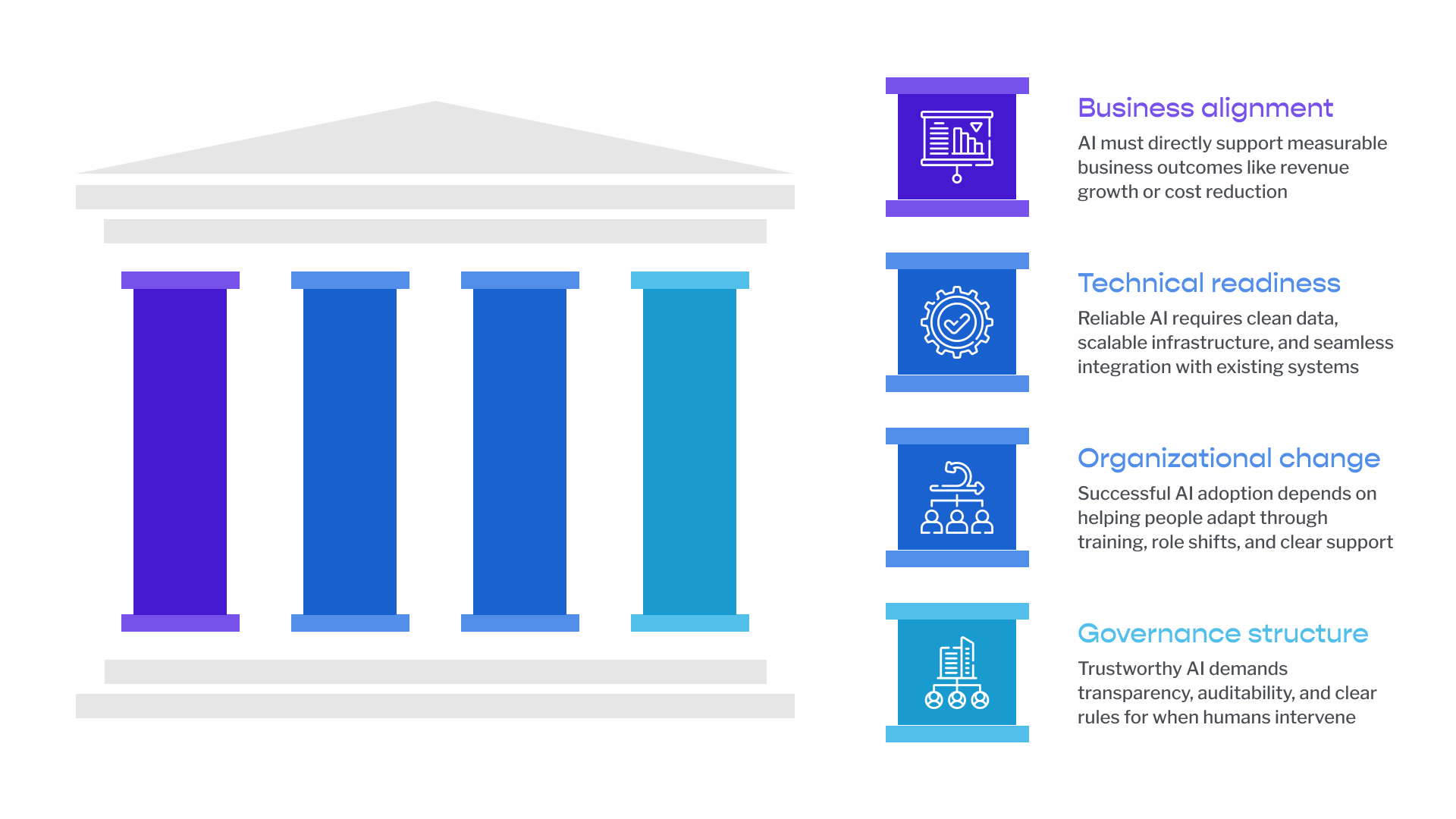

Enterprise AI implementations fail at an alarming rate. Despite massive investments in artificial intelligence, most organizations struggle to move beyond experimental pilots to production-ready systems that deliver measurable business value.
The difference between success and failure isn't technical sophistication or budget size. It comes down to four foundational pillars that must be established before deploying your first AI agent. Miss one of these pillars, and your AI initiative joins the growing graveyard of failed digital transformations.

Business alignment sounds straightforward until you witness how many organizations build impressive AI capabilities that solve the wrong problems. Proper alignment means connecting every AI initiative directly to revenue drivers and operational pain points.
Start with a fundamental question: What specific business outcomes will AI agents deliver? Not improved efficiency in general terms. Concrete, measurable impacts. Will you reduce customer response time from 48 hours to 30 minutes? Cut invoice processing costs by $1.2 million annually? Increase sales conversion rates by 23%?
The global workflow automation market is projected to reach $23.77 billion by 2025, driven not by technological enthusiasm but by clear value propositions in specific business functions. Successful organizations identify processes where AI agents can deliver 10x improvements, not incremental gains.
Your AI strategy must answer three critical questions:
Consider how Salesforce automated its lead qualification process. Instead of incremental improvements, they achieved a 50% reduction in sales qualification time while increasing lead quality scores by 35%. This dramatic impact came from aligning AI deployment with their most critical revenue driver: converting prospects into qualified opportunities.
Technical readiness extends far beyond having modern infrastructure. AI agents require robust data pipelines that deliver clean, timely information. They need integration capabilities that connect seamlessly with your existing systems. Most importantly, they demand computing resources that scale with demand.
Many organizations discover too late that their legacy systems lack the APIs necessary for real-time data exchange. Others rush to production without building proper evaluation and orchestration infrastructure. This approach is like constructing a skyscraper without laying a foundation—the higher you build, the more catastrophic the collapse.
Technical readiness also means confronting uncomfortable truths about your data quality. AI agents amplify the impact of bad data. Garbage in doesn't just mean garbage out; it means systematically wrong decisions at scale.
Your technical foundation needs five core components: clean data pipelines that update in real-time, integration platforms that connect with existing systems, scalable computing infrastructure that handles peak loads, comprehensive monitoring tools that track performance, and rollback capabilities that protect against failures.
Before deploying any AI solution, audit your data infrastructure. Can you guarantee data accuracy across all relevant systems? Do you have real-time access to the information AI agents need? Can your current architecture handle the computational demands of intelligent automation?
Technology doesn't transform organizations. People do. And people naturally resist change that threatens their expertise, routines, or job security.
Successful organizational change addresses these concerns directly. When implemented thoughtfully, workflow automation delivers a 50% decrease in employee burnout. Your team spends less time on repetitive tasks and more time on strategic thinking. But achieving this outcome requires comprehensive change management that goes beyond training sessions.
Consider how AI agents shift job roles. Customer service representatives evolve from exception handlers to relationship builders. Financial analysts move from data gathering to strategic interpretation. Marketing specialists transition from campaign execution to creative strategy development.
These transitions require new skills, different mindsets, and adjusted performance metrics. Organizations reporting 63% faster onboarding through intelligent automation didn't just deploy technology—they transformed their entire human-AI partnership model.
Your change management strategy must include skills assessment and retraining programs, clear communication about role evolution, performance metrics that reflect new responsibilities, and support systems that help employees adapt to AI-augmented workflows.
The most successful implementations create AI-human partnerships where technology handles routine tasks while humans focus on relationship building, creative problem-solving, and strategic decision-making.
Trust becomes your competitive advantage when it's built into AI systems from day one. Effective governance elevates trust to a core engineering principle, transforming experimental pilots into enterprise-ready solutions.
Every agent action must generate an audit trail. Every decision should provide clear explanations. Every outcome needs to connect directly to specific inputs and logic. This transparency protects your organization and builds confidence among stakeholders who depend on AI-driven processes.
Governance also means establishing clear boundaries. Which decisions can agents make autonomously? When must humans intervene? How do you handle edge cases that fall outside defined parameters? These guidelines protect both your organization and your customers from unintended consequences.
Your governance framework needs accountability structures that define responsibility for AI decisions, compliance protocols that meet regulatory requirements, performance monitoring that tracks outcomes against expectations, and escalation procedures that involve humans when needed.
Consider how financial services companies implement AI governance. They create decision trees that define autonomous actions, establish approval workflows for high-stakes decisions, and maintain comprehensive logs that satisfy regulatory audits. This structured approach enables AI deployment while maintaining institutional trust.
Ready to move beyond planning to actual implementation? These three steps will establish the foundation for successful AI deployment in your organization.
The four pillars, business alignment, technical readiness, organizational change, and governance structure, provide the foundation for AI success. But foundation work is just the beginning. The real challenge lies in orchestrating these elements into a cohesive implementation strategy that delivers measurable results.
Your next step isn't choosing AI technology. It's ensuring these four pillars can support the AI capabilities you plan to build. Get the foundation right, and your AI implementation becomes a competitive advantage. Skip this groundwork, and even the most sophisticated AI agents will fail to deliver lasting value.
Ready to build AI solutions that deliver measurable business value? Our team specializes in designing intelligent automation workflows that align with your strategic objectives. Explore our AI agent design process and discover how we can help you implement AI that actually works.
We’d love to bring your ideas to life.
Tell us what you’re thinking — and we’ll help shape it.

AI automation means using large language models (like GPT-4) to handle repeatable tasks inside your business. We design and build custom agents that can qualify leads, summarize content, route tickets, trigger workflows, or power internal copilots.

Not at all. While we specialize in building intelligent systems, we also offer full-service UX/UI and product design — from discovery to delivery. Many of our clients come to us purely for design support, with or without AI.

We collaborate with startups, scale-ups, and enterprise teams across fintech, SaaS, healthcare, e-commerce, logistics, and more. Whether you’re building your first product or scaling a complex system, we adapt to your stage and stack.

Absolutely. We run UX audits, onboarding redesigns, and complete product design engagements. Whether you're looking to clean up a dashboard, increase activation, or launch a new feature — we’ve got the design depth to support it.

Yes — that’s the core of what we do. We build agents that connect directly to your tools (Slack, Notion, HubSpot, CRMs, internal platforms), automate actions across them, and fit how your team already works. No need to change your stack.

No — we design every system to be maintainable without in-house ML engineers. We handle the technical setup, logic, and integrations, and offer optional support plans to monitor and optimize performance post-launch.

That’s totally fine. You can engage us for standalone UX/UI work, product discovery, or AI automation — or combine them. We’re built to plug into your priorities and scale with your roadmap.